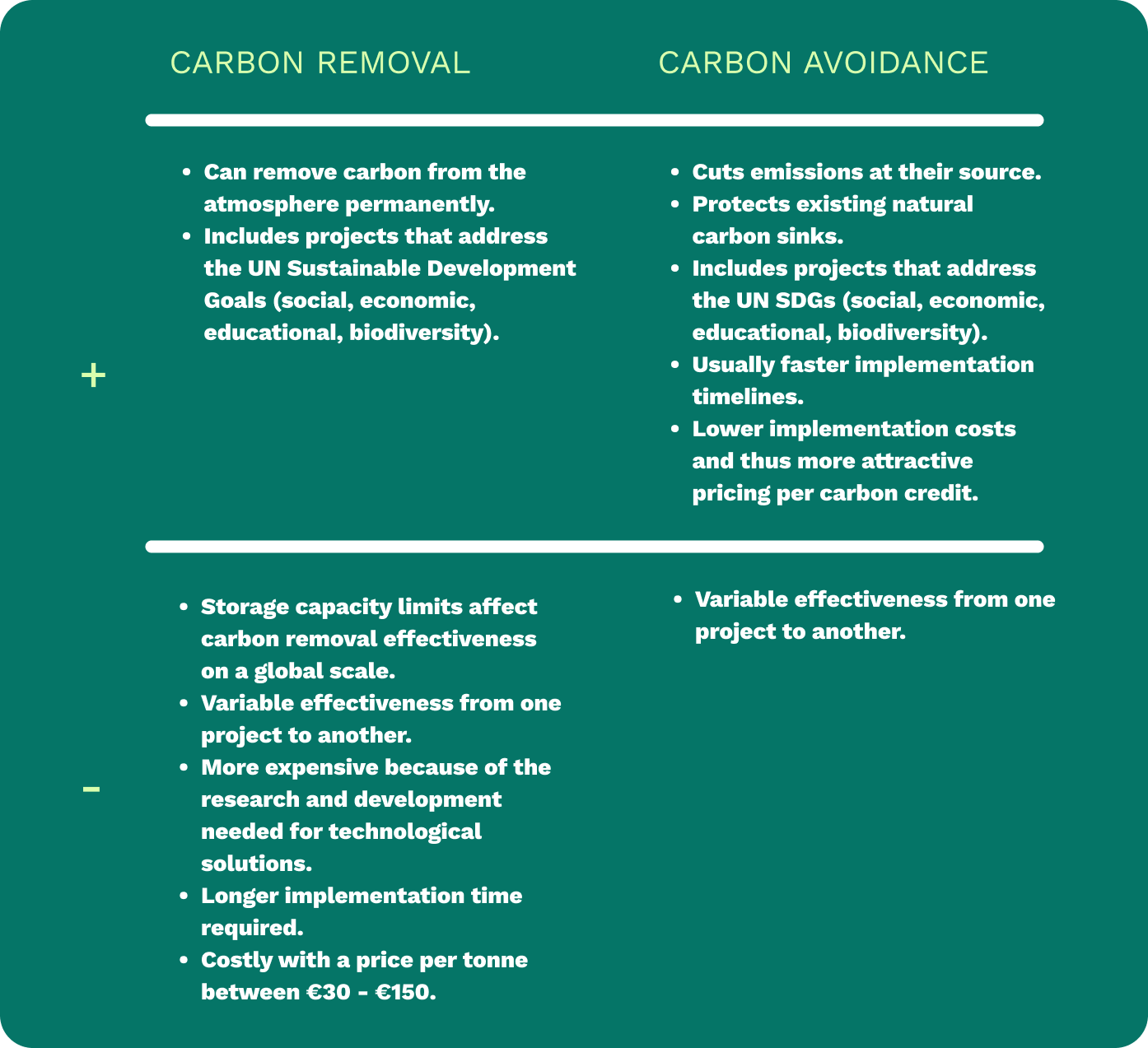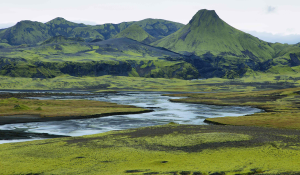The difference between carbon removal & carbon avoidance projects
Carbon reduction projects can be grouped into two main categories: carbon removal and carbon avoidance projects. They both can generate carbon credits (if certified) and are equally important in the fight against climate change.
This article will allow you to better understand the difference between the two and their specificities. Contact us for more information.

What is carbon removal ?
Carbon removal projects can take place in two ways:
-
Technological carbon removal: specialized technology extracting carbon from the atmosphere, such as Direct Air Capture (carbon is being removed from the atmosphere through chemical processes). For more effectiveness, carbon needs to be intercepted directly where it is released, often nearby industrial sites. You might also have heard of Carbon Capture Utilization and Storage (CCUS), which refers to the process of capturing CO2 and either storing it permanently or converting it into valuable products (such as methanol).
-
Natural carbon removal: enhancing the capacity of a forest to pull carbon out of the atmosphere through photosynthesis by preserving existing carbon sinks and creating new ones: reforestation and afforestation. Mangroves also have high carbon absorption capacities. Other projects include agricultural projects.
What is carbon avoidance ?
There are five main project typologies that fall into the category of avoidance projects:
- Forestry and land use: These projects involve activities such as forest management planning, timber production, agroforestry practices, and land-use optimization.
- Renewable energy: Contributing to decarbonizing the local power grid through renewable power infrastructure and thus prevent GHG emissions released into the atmosphere.
- Fuel-switching: Using a less carbon intensive energy source leading to lower carbon emissions.
- Household devices: Using efficient cookstoves which require less wood for daily cooking, and thus contribute to reducing deforestation. These project's benefits can include gender equality, health benefits, income generation, knowledge building, and environmental preservation.
- Waste management: Rather than considering waste as the final step in the production process, these projects are actively utilizing waste to generate energy, minimize pollution, and mitigate carbon emissions.
Is it better to support carbon removal projects or carbon avoidance projects?
One should not be promoted at the expense of the other. They are both essential to achieve a net-zero future. However, it is certainly true that only supporting removal projects doesn’t address the initial problem of greenhouse gas emissions being released into the atmosphere.
We need to reduce our emissions and find innovative ways to limit the damage already done. In addition existing carbon sinks need to be protected while new ones are created.

For more information on Carbon Removal Methods, download our guide.
ClimateSeed's premium carbon removal and avoidance projects
At ClimateSeed, we offer both carbon removal and avoidance projects in our portfolio. We have dedicated experts that ensure projects are of the highest quality, and have passed our robust three-level verification process. Our unique approach maximizes your positive environmental and social impacts, and offers risk mitigation backed by top-tier financial expertise.
Project example: Agroforestry in Punjab
The state of Punjab is an agriculture intensive state with a traditional rice-wheat cropping system that has contributed towards food security of the country. However, the productivity of this system has declined in certain areas due to depletion of nutrient reserves, lowered underground water table and resurgence of insects and diseases. The project promotes sustainable agroforestry and addresses the growing demand for timber and tree-based products by providing for these materials, while at the same time conserving and rehabilitating entire ecosystems. Through this project, 24.8 million tCO2e will be sequestered throughout the 40 years of the project.
 Agroforestry in Punjab
Agroforestry in Punjab
The project contributes to both nationally stated sustainable development priorities:
- Increased yields of crops, thus raising agricultural production and incomes.
- Improved management of agricultural land as a result of adoption of good practices, thereby increasing the adaptive capacity of the farming system to climate change impacts.
These projects fall into the "Afforestation, Reforestation, and Revegetation" (ARR) category of the Verified Carbon Standard (VCS).
For more information on this project, read our case study.
Contact us for more information.
Q&A
ClimateSeed employs a thorough, multi-stage process to select its projects, ensuring only the highest quality initiatives with positive environmental and social impacts are chosen. The selection process begins with each project obtaining certification from recognized international or national standards. Next, ClimateSeed's team of experts evaluates the projects based on a range of criteria, including typologies, methodologies, and geographical areas. A preliminary bank check is also conducted for all project sponsors. Finally, the projects undergo an assessment using a specialized evaluation framework developed by ClimateSeed's experts. For more information, please contact us.
Mangroves play a crucial role in the natural sequestration of carbon by absorbing and storing large amounts of CO₂ from the atmosphere. Thanks to their dense root systems and their ability to accumulate organic matter in waterlogged soils, they capture carbon efficiently and sustainably. Mangrove soils can store up to four times more carbon per hectare than terrestrial forests, making them essential ecosystems for mitigating climate change. For more information on this topic, read our article.
Share this
You May Also Like
These Related Stories

How to select climate contribution projects?

Carbon Emission Avoidance: Principles, Calculation, and Key Issues


